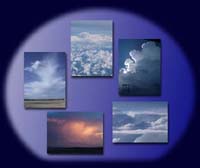Dust and Haze |
|
| Hazy Atmosphere | |
| Urban Air Pollution | |
| Smog at Crete | |
| Inversions | |
| Dust Devil | |
| Sahara Dust | |
| Seasalt Aerosol | |
| Overview | |
Sahara Dust
|
Mobilization: Strong sand storms often
occur in the Sahara. If they occur in certain, so-called source
regions, aerosol particles can be suspended by "soil creep"
and "saltation" into the atmospheric boundary later located
directly above the ground. In the case of "soil creep"
large grains of sand are blown by the wind over the desert ground.
When the wind is strong enough single grains can be raised in the
air and move a bit further. These large and heavy grains fall back
to the ground as if they just have jumped. Thereby they destroy
agglomerates of other grains and fine particles on the ground. During
a strong sand storm there is often a huge layer of several meters
high consisting of turbulent swirling and saltating grains of sand,
so that the process of soil creep and saltation finally acts like
a sandblast with immense erosion power. The swirling grains of sand
are too large to be transported far away or up to high levels. But
because agglomerates are destroyed by the "sandblast"
aerosol particles are formed (i.e. "mobilized") which
have a size smaller than few micrometers down to the submicron range.
Their sedimentation velocities are small enough that the particles
are suitable for the so-called "long range transport".
Europe.jpg shows a long range transport event that occurred in 2001. Here the aerosol was finally detected in Northern Europe. The haziness of the atmosphere above France as well as in its north-eastern direction and the English Channel can be clearly noticed. The aerosol particles often pass also the Alps. There the airborne particles can be deposited as yellow, fine, dry precipitation. Or the particles can be washed out from the atmosphere by rain. In 2003 aerosol particles from the Chinese Taklamantan desert was finally found in the snow of the Alps. This event includes a transport range of 20 000 km passing the Pacific Ocean, North America and the Atlantic Ocean within approximately fourteen days. |
SaharaDust1+2.jpg: DustStorm3+4.jpg were taken from the American Seawifs satellite.
The aerosol particles derived from a sand storm in the Sahara and
were lifted by the warm thermal updraft up to altitudes of 4500
meters. Within a few days the particle cloud extended over the Canaries
to the Azores. Effects: All in all deserts globally produce around 2 billion tons of dust. Approximately 80 % derive from the deserts Gobi, Sahara and Taklamatan. The desert dust plumes absorb shortwave radiation of the sun and - depending on their optical thickness - can lead to heating inside the dust layer. On the other hand they also reflect sun-light into space. Due to the loss by absorption and reflection the earth surface beneath the dust layer gets less sun-light. Hence there might be minor, locally and temporally limited cooling. |
Recently it is assumed that so-called heterogeneous chemical reactions
take place at the surface of the dust particles which destroy ozone.
Furthermore it is known that the deposited desert dust has a fertilizing
effect on the environment. For example minerals - mostly phosphates
and iron - are imported that way. Sahara dust events over the Eastern
Atlantic Ocean often coincide with plankton blooming in this area.
It is assumed that the constituents of the dust particles might
have a positive influence on the African rainforests, too. This
might be also the case for the plants living in the Amazon basin
which can extract nutrients from the deposited dust. However, strong
dust precipitation can pollute corals of the Caribbean and inhibit
their growth. Plankton blooms deriving from Sahara dust fertilization
can also lead to algae growth which again inhibits the growth of
the corals. The iron-containing soils on some of the West Indies
have formed as a consequence of long-time accumulation of Saharan
Dust. All in all the airborne desert dust is related to a lot of
physical, chemical and biological mechanisms. |
![]()






